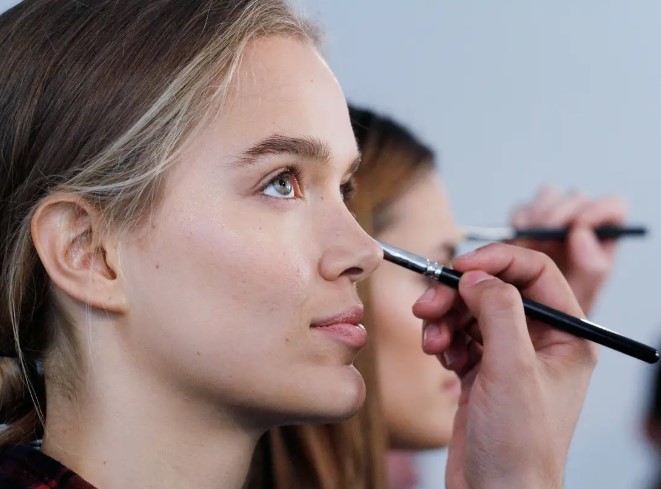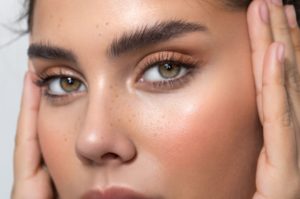Concealer is the multi-purpose makeup that you are always able to trust. It can be used on daily basis or to put on your travel kit bag as a part of your makeup regime essentials. Concealer works together with foundation to offer extra coverage to accomplish even and smooth skin tone appearance. The first use of concealer can be traced back on 1920s to cover varicose veins, conceal birthmarks and pigmentation, mask burns, or disguise dark circles under eyes. However, there is still debate that’s going around even to these days: is actually better to apply concealer before or after foundation?
These days there are various types of concealer available – it all depends on what you’re trying to achieve and whether you put the concealer before or after foundation. Both foundation and concealer are available in different opacity, but in general the latter is more heavy-textured and pigmented than the earlier. According to their uses, there are blemish concealer, highlighting or brightening concealer, and color correcting concealer. The forms of concealer vary from liquid, cream, stick, to pencil concealer. Before you dive into the right steps to apply makeups, it might be better to learn about these types of concealer first. It allows you to understand better about the makeup, if you aren’t familiar yet with its various terms.
Concealer Types According to Their Purpose
Despite your preference to use concealer before or after foundation, there are different types of concealer that carry different formula. Here are three of the most common types of it:
- Highlighting/brightening concealer
People usually tend to choose one or two shades lighter of a concealer than their skin tone if they want to use it to brighten or highlight their facial features. This concealer type is your best friend if you want to combat dark circles that appear due to the fact that you don’t get enough rest or good night sleep. Using it to highlight certain parts of the face is also becoming a trendy makeup technique recently.
- Blemish concealer
Blemish or spot concealer is typically rich of pigment and thick in texture. It is used to hide acne or the scar of it. Nowadays, there are many concealers that are available with anti-acne formula to help heal the skin in addition to cover them.
- Color correcting concealer
This concealer type involves many color tones such as green, purple, peach, etc. to cancel the skin discoloration or its dullness. It is important to remember that you should only use color correcting concealer in thin layer to prevent it peek through the makeup.
Concealer Types According to the Form
Doesn’t matter whether you apply concealer before or after foundation you should choose one that matches with your skin type, tone, and concern. Here are several types of it according to its form:
- Liquid concealer
Due to its ability to work with most skin types, liquid is the most popular form of concealer. It rarely settles into scars or bunches up on acnes. Most of them also have buildable coverage to give you different finishes.
- Cream concealer
In general, cream concealer can provide more coverage than the liquid one due to its heavier texture. However, there is some downside that you must be careful. The intense pigmentation it carried can look heavy when applied with brush.
- Stick concealer
Similar to creamy one above, the stick concealer is also thicker than liquid and offers high coverage. It is suitable to bring on travel, because of the packaging is very convenient. It can blend on skin easily to give you flawless skin all day.
- Pencil concealer
Even though it can be considered as the rarest concealer form, it works very great to give brightness to eyes area or to clean the eyebrow shape.
Tips to Apply Concealer Flawlessly
The more often you incorporate concealer into your daily makeup routine; you will realize more how multipurpose it is. It can cover things, accentuate parts, and even create fuller illusion. Read these several tips to start increasing your concealer game:
- Prep with primer first
To get your skin prepared by a nice start, prep it with primer. The primer will provide smooth surface that’s easier to work with when you apply concealer.
- Do pat instead of rubbing it
Instead of rubbing the concealer and risk to smear the rest of your makeup, try to pat it gently. Use your ring finger to apply in dabbing motion and blend it carefully into your skin. Do not move the concealer to the parts of your face that do not need to be concealed.
- Cover up your makeup mistake with it
Concealer has coverage power that you must never underestimate. In case of an emergency when you make a mistake, dip your angled brush into liquid concealer and perfect the mistake on application.
- Blot with tissue to avoid cakey look
The eye area is the frailest feature that can get cakey easily. To avoid this problem, put thin tissue to blot the area after you apply concealer.
So, Is It Better to Apply Concealer Before or After Foundation?
The order to use makeup, such as using concealer before or after foundation, depends a lot on each individual so to be fair, no technique is necessarily better than another. However, sometimes there are some clear rules that need to be followed. For example, color-correcting concealer needs to be always applied first before foundation, with a layer of thin skin tone concealer in-between.
The most common order that mostly agreed by makeup professional to answer the debate whether to apply concealer before or after foundation is to apply the foundation first. This approach is more popular as you can control the amount of concealer applied, thus preventing the foundation to build up and crease, or the blemishes to peek through. Besides, the initial purpose of concealer is to support foundation – you cannot possibly know the amount of concealer you actually need to use before seeing how well the foundation work to reduce uneven skin tone such as the redness, discoloration, or excess redness.






